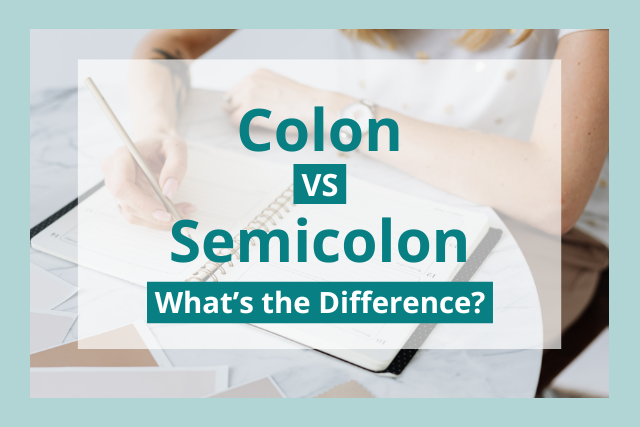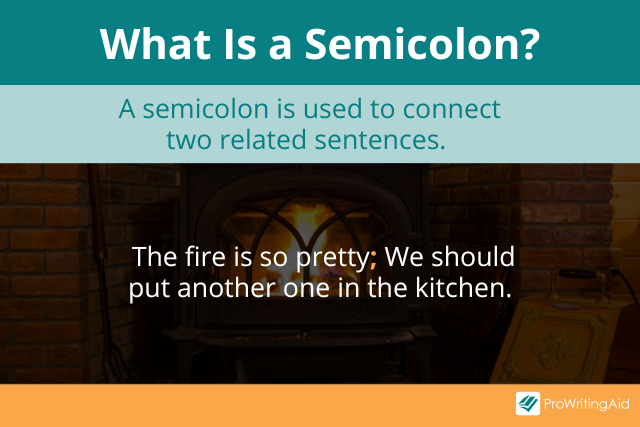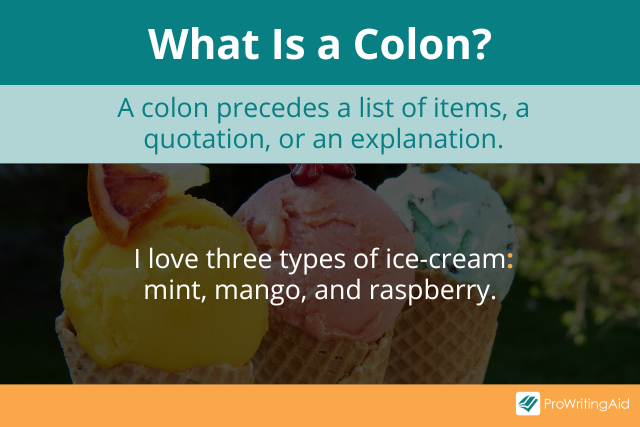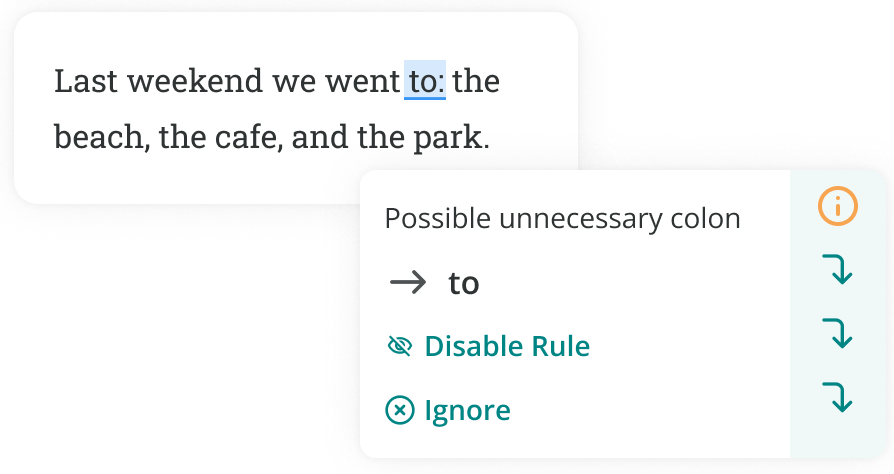
Many people use the wrong punctuation marks when writing.
For example, the colon and semicolon are possibly the most misunderstood and misused punctuation marks in English grammar.
Both punctuation marks help to improve sentence structures but in different ways. A colon is used to introduce information, while a semicolon is used to connect two sentences.
In this article, we’ll look at all the different uses of the colon and semicolon with example sentences for each.
Semicolon vs Colon Symbols
A colon is a punctuation mark that looks like two periods on top of each other (:), while a semicolon looks like a period on top of a comma (;).
Both a colon and semicolon show a pause in a sentence. However, they do this in different ways.
A colon is used to introduce information like a quotation or list. A semicolon is used to separate two related independent clauses.
When to Use a Semicolon
A semicolon is used to connect two related sentences. Here are three ways you can use a semicolon to join two sentences.
1) To join two independent clauses
- Charlie really loves tacos; they may be his favorite food in the world.
In the case above, the two sentences could easily stand on their own with a period placed at the end of each sentence. However, since the ideas in the clauses are so closely related, you can use a semicolon instead.
2) To join two independent clauses separated by a transitional phrase or conjunctive adjective
- Hillary is a skilful racer; moreover, she is a careful one.
When your sentence consists of two independent clauses that are linked by a transitional phrase or conjunctive adjective, you can either use a semi colon or a period between the two clauses. Some examples of transitional phrases are after all, as a result, and even so. Some examples of conjunctive adjectives are accordingly, finally, moreover, and likewise.
3) To separate items in a list
Semicolons can also separate items in a serial list. The items in a serial list are complex and already have commas in their descriptions.
If you used more commas to separate the items listed, it would create confusion, so a semicolon is a better option. The semicolon helps the reader to keep track of the separated items.
- Yesterday I met four dogs. Buster, who is a daschund; Archie, who is a lurcher; Frank, who is a Jack Russell; and Jemimia, who is a pug.

Now you know the do’s of using a semicolon, let’s look at two don’ts.
1) Don’t use a semicolon and a conjunction
Conjunctions are used to connect independent clauses much like semicolons. They serve the same purpose, and should therefore never be used together in the same sentence. For example:
Incorrect: This work isn't mandatory; but we still need to prove we've done it.
Correct: This work isn't mandatory, but we still need to prove we've done it.
Correct: This work isn't mandatory; however, we still need to prove we've done it.
2) Don’t use a capital letter after a semicolon
Even though both clauses being separated by a semicolon could stand on their own, you shouldn’t start the second clause with a capital letter. The only exception is if the first word in the second clause is a proper noun.
Incorrect: Charlie really loves tacos; They may be his favorite food in the world.
Correct: Charlie really loves tacos; they may be his favorite food in the world.
Correct: Charlie really loves tacos; Penelope does not.
Semicolon Sentence Examples
Here are some more examples of how to use semicolons in sentences for each of the instances we mention above.
1) To join two independent clauses
- Kieran finished all his dinner; Joeseph did not finish his.
- Gary loves visiting hot countries; the beach is his favorite holiday destination.
- I did all I could; I even went door to door asking for help.
- It was hilarious; she couldn't stop laughing.
2) To join two independent clauses separated by a transitional phrase or conjunctive adjective
- Our cook’s specialty is pan-fried sea bass; however, it is not available tonight.
- That’s a tough question; in other words, I’m not going to even try to give you an answer.
- Vacations always used to be a luxury; however, in today’s working world, they have become a necessity.
- Charlie really loves tacos; in fact, they may be his favorite food in the world.
3) To separate items in a list
- We visited to Rome, Italy; Paris, France; and London, England.
- I live with Nick, a journalist; Priscilla, an aerospace scientist; and Matilda, an influencer.
- You can get eggs, salt, and milk from the local store; rosemary, thyme, and celeriac from the farmer's market; and sausages from the butcher.
When to Use a Colon
The colon has several functions. It introduces independent clauses that explain or amplify the previous clause. It can introduce words, phrases, lists of items, explanations, and elaborations.
You can think of a colon as another way of saying “that is to say” or “here’s what I mean.” A colon also performs mechanical or non-sentence functions.
Let’s look at each function of a colon.
1) To introduce additional information, such as a list, quotation, or a noun or noun phrase.
A colon is often used to introduce information. The colon helps draw attention to the items it precedes, whether that be a list, quotation, or noun.
- A list: We covered many of the fundamentals in our writing class: grammar, punctuation, style, and voice.
- A noun or noun phrase: The central theme of the movie was something we've all experienced: grief.
- A quotation: Shakespeare said it best: “To thine own self be true.”
2) To join two related sentences
If you have written two related sentences that are independent, you can connect them with a colon. Sentences are related when the second sentence gives more information on, gives related examples to, or rephrases the first one.
- Julia was excited: she had never been to a concert before.
Only capitalize the first letter after the colon if it’s a proper noun or a quotation. But if you ever make a mistake, ProWritingAid can correct any instances of incorrect capitalization.
3) A part of writing mechanics
Let’s look at the six mechanical uses of the colon.
- Time: 08:30
- Titles: 2001: A Space Odyssey
- Ratios: 1:7
- Periodical citations: Old English Literature 123:7-14
- Bible verses: Mark 1:12
- Correspondence: To Whom It May Concern:

Colon Sentence Examples
Let’s look at some more examples of how to use a colon.
1) To introduce information
- I bought three types of vegetables: carrots, peas, and parsnips.
- My high-school English teacher taught us something I'll always remember: “The best books can always be read twice.”
- My new job gave me the things I wanted most: camaraderie and excitement.
2) To join related sentences
- Growing up is like algebra: half the enjoyment is in trying to figure it out.
- The biologist's life work revolved around one central question: What would the world be like if there were no turtles?
- Christine deserved her mathematics award: she got what she worked hard for.
3) A part of writing conventions
- You can make the best pancakes with a 1:3 water to flour ratio.
- We will arrive home from the airport at 8:30 a.m.
- Have you seen the movie Fast and Furious: Tokyo Drift?
Conclusion on Semicolon vs Colon
The semicolon and colon are commonly misused punctuation marks, but knowing the basics will really help.
Just to recap, a colon is used to introduce, clarify, or explain the preceding information. A semicolon is used to connect two independent clauses that can stand on their own but are related in some way.

Punctuation use can be tricky because there are so many rules. Always use ProWritingAid to show you where you might have misused any punctuation mark. See where might have a comma splice so you can add a semicolon. Or see if you’ve used a colon unnecessarily so you can remove them.

